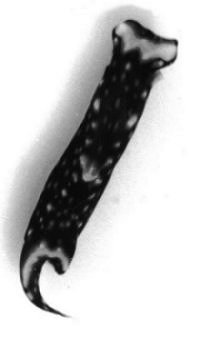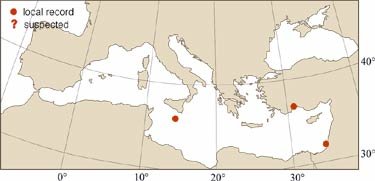
|
Relevant Synonyms
Misidentification
|
|
| photo: G. Gat |
|
SHORT
DESCRIPTION
color :
very typical pattern of yellow-orange spots on a velvet black or dark brown background with blue reflections. A distinctive W pattern of white pigment on the head and also a white or pale yellow crescent on the rounded posterior margin of the head shield are present.
common size :
between 10 and 20 mm - the largest specimen known of this species (33 mm) was found in Malta (Sammut and Perrone, 1998) - with a shell about 4-6 mm. |
DISTINGUISHING CHARACTERISTICS
BIOLOGY / ECOLOGY
habitat :
according to Marshall and Willan (1999), it lives in sandy bottoms, generally where algal debris accumulate, from low intertidal (where commonest) to 20 m deep. Only a few specimens have been found in the Mediterranean, under stones at 3 m, and on rocky bottoms 12 m deep. |
|
1st
Mediterranean record
|

|
|
DISTRIBUTION
|
ESTABLISHMENT SUCCESS
speculated reasons for success :
|
|
|
MODE OF
INTRODUCTION |
IMPORTANCE TO
HUMANS |
|
KEY
REFERENCES
|
|
|
 Chelidonura mediterranea Swennen, 1961
Chelidonura mediterranea Swennen, 1961